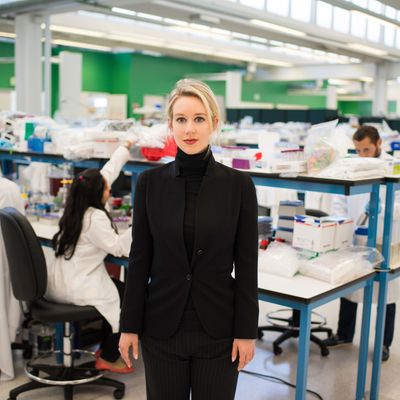
As the trial of Theranos founder and former CEO Elizabeth Holmes begins, Vulture is recirculating coverage of the documentary The Inventor, which you can watch on HBO Max.
Alex Gibney is obsessed with Elizabeth Holmes’s face, and by the end of The Inventor: Out for Blood in Silicon Valley, you probably will be, too. We see a lot of it, often in extreme close-up, that crush of mascara and smear of eyeshadow, the unblinking Mona Lisa smile. It can shift from beatific to deranged in a split second, with only the slightest shift in facial muscles. By making us stare for so long into Holmes’s big, blue, bloodshot eyes (she was said to only sleep four hours a day, and that part at least shows), it’s as if Gibney’s trying to hypnotize us by proxy, to visually turn her into the Silicon Valley illusionist that The Inventor reports her to be.
Before her downfall, and the spectacular implosion of her biotech start-up, Theranos, Holmes did have a kind of captivating effect on Silicon Valley. As a comparatively young woman (she was 30 when she made the Forbes 400, based on the $9 billion valuation of her company) and a Stanford dropout, she was seen as a renegade and a beacon, a female disruptor in a sea of men. The problem was that the sector she was disrupting — the medical sector — isn’t, say, ride-sharing. People’s lives are in the balance, and “faking it till you make it” — which, it was revealed, had been most of Theranos’s MO up until the end — can have disastrous consequences.
But the magic box Holmes claimed to have invented, a laser-printer-sized diagnostic machine called the Edison, which supposedly could run up to 200 tests on a few drops of blood, would be a miracle if it were to exist. And the collective desire for that miracle to come true — from Holmes, her billionaire backers, and the public at large — fueled years of fakery and deception. Gibney uses the convenient invocation of Thomas Edison to place Theranos within the context of a history of American entrepreneurial fakery, and uses the visual motif of Edison’s early film tests to create a visual metaphor for the illusory nature of invention.
It’s an interesting idea, but The Inventor ultimately can’t decide if it’s about the specific, contained absurdities of the Theranos scam, or the phenomenology of scams like Theranos. There’s certainly plenty of material to pore over on the former, but any attempts to go bigger-picture feel surface-level and abbreviated. Perhaps a ten-hour-long, O.J.: Made in America–style docuseries could satisfyingly address the systematic, cultural context of Elizabeth Holmes; that’s not this film by a long shot.
But when Gibney stops to savor some of the specifics, the film is at its best. One of the most memorable images in any documentary this year will surely be that of a CGI recreation showing the disastrous insides of an Edison box, splattered with blood samples, broken pipettes, and roving, infected robotic needles, lying in wait for anyone who would dare stick their hand inside to fix something. There’s also some cringing schadenfreude when Gibney gets into Theranos’s marketing and public image, pulling liberally from footage shot by a chuckling, credulous Errol Morris for a TV spot. (As Atlantic critic David Sims pointed out, it also offers some juicy documentarian-on-documentarian criticism.)
The image of Holmes’s face, particularly some unsettling Interrotron footage shot during that Morris spot, is what Gibney keeps coming back to, though. At times it feels a little obsessive — Holmes is guilty of many a crime, but her face, however unflinching, would seem to rank low on that list. It’s almost as if he, and everyone from The New Yorker’s Ken Auletta to whistleblower Erika Cheung to all the investors and people who got burned by Holmes, are trying to see if the source of her ultimately misled determination to change the world is somewhere in her eyes, in her skin — if there was some way we could have known. But all good illusionists know to get their audiences so fixated on one thing that they’ll miss what they’re doing behind their backs.

